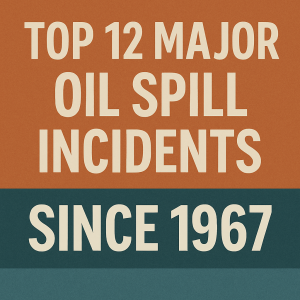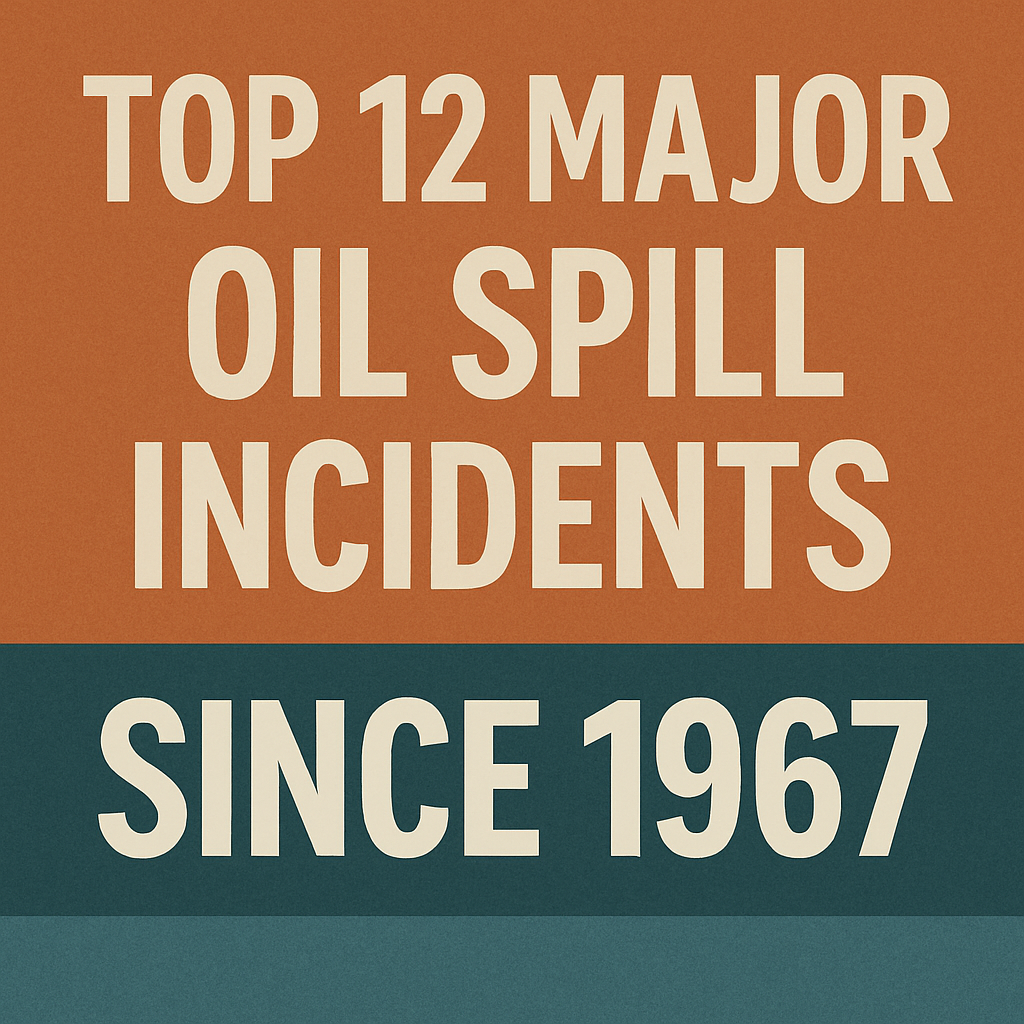Explore the top 12 worst oil spills in maritime history, their causes, environmental damage, and how they reshaped global maritime regulations and oil transportation practices.
Oil spills are some of the most catastrophic events in maritime history—inflicting irreparable harm on marine ecosystems, coastlines, and local economies. These events often reshape public opinion, prompt sweeping regulatory changes, and bring the cost of operational error or design failure into the spotlight. In this comprehensive article, we revisit the top 12 worst oil spills in maritime history, highlighting the lessons learned and how global regulations have evolved to prevent similar disasters.

Why Oil Spills Still Matter in Modern Maritime Operations
Despite advances in double-hull designs, electronic navigation systems, and stricter oversight from classification societies and flag states, oil spills remain a serious concern. According to the International Tanker Owners Pollution Federation (ITOPF), the number of large spills has decreased significantly over the past three decades, but the impact of any major incident remains profound.
The International Maritime Organization (IMO), through MARPOL Annex I, mandates oil pollution prevention measures, but enforcement is uneven across jurisdictions. Moreover, geopolitical tensions, aging fleets, and human error still contribute to risks.
The World’s 12 Worst Maritime Oil Spills
1. Persian Gulf War Oil Spill (1991) – Persian Gulf
Estimated Spill: 1,000,000 tonnes
Cause: Deliberate release during conflict
The largest oil spill in history wasn’t accidental. Iraqi forces intentionally released crude oil into the Persian Gulf during the Gulf War. The resulting slick covered over 11,000 square kilometers, devastating marine life and mangroves, particularly around Kuwait and Saudi Arabia.
2. Deepwater Horizon (2010) – Gulf of Mexico
Estimated Spill: 780,000 tonnes
Cause: Blowout of drilling rig operated by BP
Often referenced as the most environmentally destructive spill in U.S. history, this disaster resulted from a failure in well integrity and the blowout preventer system. It led to a $65 billion cleanup and damage payout by BP and prompted reforms in offshore drilling safety across the world.
3. Ixtoc I (1979) – Gulf of Mexico
Estimated Spill: 454,000 tonnes
Cause: Blowout at exploratory well
Operated by Mexico’s PEMEX, Ixtoc I spilled oil continuously for nearly 10 months. It had a significant impact on tourism and fisheries in Mexico and Texas. This spill highlighted the need for deepwater containment techniques, which were still rudimentary in the late 1970s.
4. Atlantic Empress (1979) – Caribbean Sea
Estimated Spill: 287,000 tonnes
Cause: Collision during tropical storm
This Greek-flagged VLCC collided with the Aegean Captain off Trinidad and Tobago. Both vessels were loaded with crude, and the incident caused fires and the release of vast oil quantities. The tragedy underscores how weather and poor navigation coordination can lead to disastrous outcomes.
5. ABT Summer (1991) – Off Angola
Estimated Spill: 260,000 tonnes
Cause: Explosion and fire onboard
While en route from Iran to the Netherlands, this Liberian-flagged tanker exploded and burned for three days. The fire, which took the lives of five crew members, resulted in one of the largest offshore oil slicks in African waters.
6. Nowruz Field Platform Spill (1983) – Persian Gulf
Estimated Spill: 260,000 tonnes
Cause: Tanker collision with offshore platform
During the Iran-Iraq War, a tanker collided with an Iranian oil platform. Due to the war conditions, repair and containment efforts were delayed for months, worsening the environmental impact.
7. Castillo de Bellver (1983) – South Africa
Estimated Spill: 252,000 tonnes
Cause: Fire and structural failure
A Spanish tanker caught fire near Cape Town, broke in two, and sank. Fortunately, winds and currents carried the oil offshore, sparing the coast, but the ecological damage to marine life was still severe.
8. Amoco Cadiz (1978) – Brittany Coast, France
Estimated Spill: 223,000 tonnes
Cause: Grounding after steering gear failure
One of the most notorious spills in European waters, Amoco Cadiz released its full cargo of crude oil just off the French coast. It led to MARPOL amendments and helped shape the European Union’s current maritime safety protocols.
9. MT Haven (1991) – Mediterranean Sea, Italy
Estimated Spill: 144,000 tonnes
Cause: Explosion during unloading
A converted ULCC caught fire off Genoa and eventually sank. The cleanup was complicated by depth and marine traffic. The site remains one of the largest diveable wrecks in the Mediterranean.
10. Odyssey (1988) – North Atlantic
Estimated Spill: 132,000 tonnes
Cause: Explosion and breakup in storm
This American tanker exploded during a severe North Atlantic storm. The remoteness of the location hindered emergency response and allowed the oil to spread unchecked.
11. Exxon Valdez (1989) – Alaska, USA
Estimated Spill: 37,000 tonnes
Cause: Grounding on Bligh Reef
Though smaller in volume, the Exxon Valdez spill had outsized media and environmental impact. It contaminated over 2,000 km of Alaskan coastline, led to massive marine bird and otter deaths, and became the catalyst for the U.S. Oil Pollution Act of 1990.
12. Prestige (2002) – Spain
Estimated Spill: 63,000 tonnes
Cause: Hull failure during storm
The aging single-hull tanker split in two and sank off the Galician coast. The spill affected over 1,300 km of coastline. It triggered regulatory action in the EU banning single-hull tankers from its ports, years ahead of global IMO deadlines.
How Oil Spills Shaped Maritime Regulation
Each major spill has influenced legal frameworks. The Exxon Valdez led directly to the OPA 90, mandating double-hull construction and improved contingency planning. Similarly, MARPOL Annex I was strengthened post-Amoco Cadiz. Today, IMO GISIS helps track incidents globally, while Port State Control regimes under the Paris MoU and Tokyo MoU audit vessels for pollution risk compliance.
Organizations like Lloyd’s Register, ClassNK, and DNV also enforce construction and safety standards that aim to mitigate risks of structural failure, explosion, and grounding. Meanwhile, insurance underwriters like P&I Clubs tie premiums to compliance records and risk management systems.
Real-World Impacts: Ecology and Economy
Oil spills often result in:
- Collapse of fish populations (as with the Nowruz spill)
- Long-term damage to coral reefs and seagrass
- Destruction of seabird colonies (e.g., Prestige, Exxon Valdez)
- Health impacts on coastal communities
- Multi-billion-dollar economic losses in fisheries and tourism
In the aftermath, some ecosystems take decades to recover, while others never fully return to pre-spill conditions. Reports from NOAA, IMO, and Marine Pollution Bulletin suggest that even 10-20 years post-incident, oil residues can persist in sediment.
Frequently Asked Questions
How does oil spill cleanup work?
It often involves mechanical recovery (booms, skimmers), dispersants (chemicals that break oil down), and bioremediation (bacteria to consume hydrocarbons). Weather and location significantly impact success.
What is MARPOL Annex I?
It’s the IMO regulation that sets international standards to prevent oil pollution from ships, including design, operation, and reporting protocols.
Are oil spills still common today?
Major spills are less frequent, but minor spills remain common, especially in congested or war-affected regions. Poor enforcement, aging tankers, and illegal discharges are ongoing risks.
What happens legally after a spill?
Depending on jurisdiction, shipowners may be liable under the CLC Convention, Fund Convention, or national laws like OPA 90. Investigations by flag states, classification societies, and insurers follow.
Can oil spills be predicted or prevented?
To an extent. Predictive maintenance, real-time monitoring, ECDIS integration, and AIS tracking help reduce risks. However, extreme weather and human error still present challenges.
Conclusion
The worst oil spills in maritime history serve as stark reminders of what’s at stake when safety, regulation, or preparedness fails. Each tragedy has spurred innovation—from double-hull tankers to satellite spill detection. For maritime professionals and students alike, studying these events is not just about the past, but about shaping a safer, cleaner future for global shipping.
As we move toward an era of zero-emission vessels, alternative fuels, and stricter environmental controls, the legacy of these oil spills must inform every decision made on the bridge, in the engine room, and at the IMO negotiating table.
References
- International Tanker Owners Pollution Federation (ITOPF)
- IMO MARPOL Annex I
- Marine Pollution Bulletin (Elsevier)
- U.S. NOAA: Exxon Valdez Restoration
- IMO GISIS Marine Casualties and Incidents
- UNCTAD Review of Maritime Transport
- Paris Memorandum of Understanding on Port State Control
- U.S. Oil Pollution Act of 1990 (OPA 90)
- MarineTraffic Real-Time Ship Tracking
- P&I Clubs and Marine Liability Coverage

